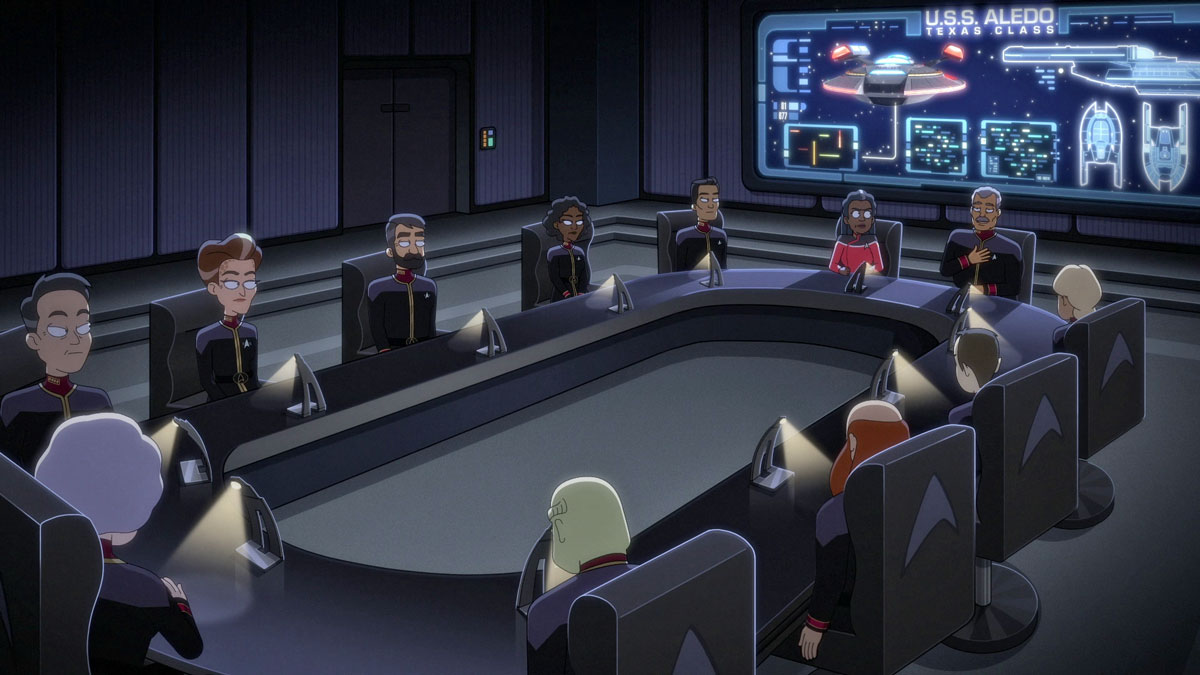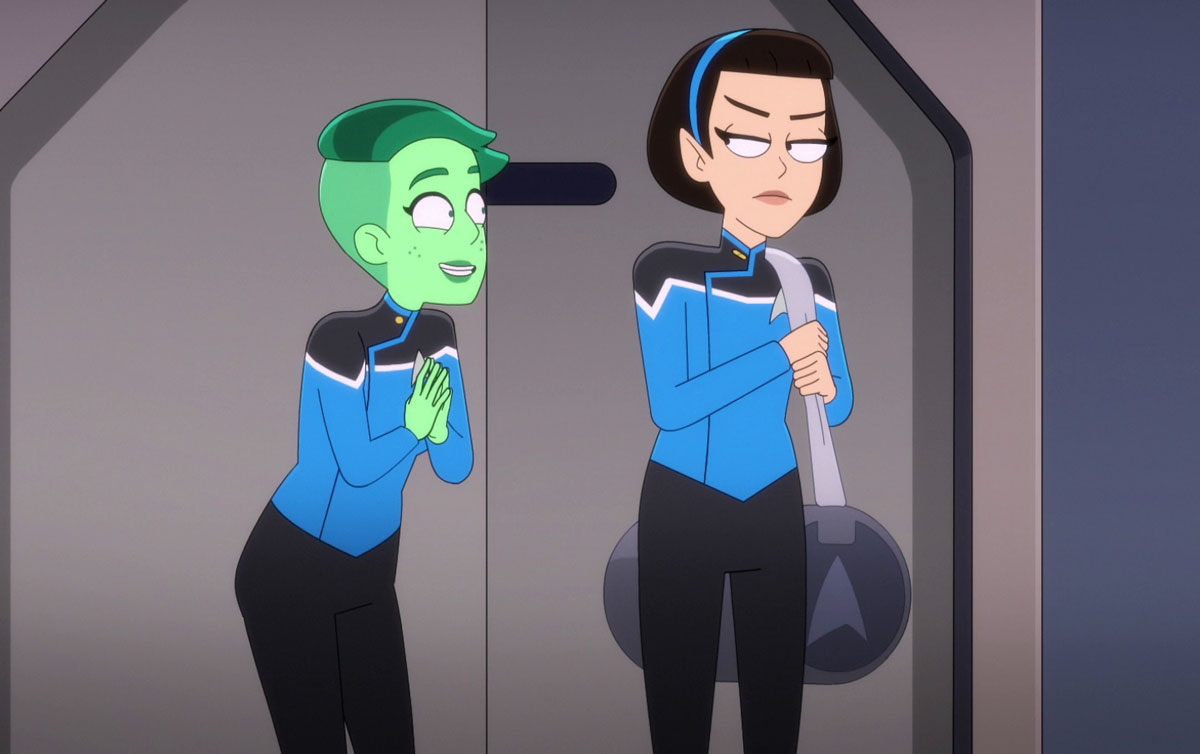Star Trek: Lower Decks wraps up its third season with the Mike McMahan-scripted “The Stars at Night,” another barnstormer of a finale which capably wraps up some of the story threads that have been developed this season — without leaning on any flashy legacy characters or concepts — and it’s exciting to see the show having reached this level of self-confidence.
Be sure you watched the post-credits scene!
Don’t get me wrong, I adore “No Small Parts” and “First First Contact” for their thrilling legacy character connections, and those two finales are probably slightly stronger finales than “The Stars at Night” overall. But it’s exciting that in this time around, Lower Decks decided to focus on the lore it has built for itself over the last three seasons, and ground that exclusively with its own characters.
As the show continues to evolve and develop, it’s got its own recurring cast of characters and story beats that are developing their own depth and wiring the nostalgic connections in our brains that make us want to see more of them. I can’t be the only one who cheered at that surprising post-credit scene!
“The Stars at Night” picks up after the events of last week’s “Trusted Sources,” with the Cerritos in for repair at Douglas Station — while Captain Freeman consults with Starfleet Command on Earth. The successful debut of the fully automated Texas-class leads Admiral Buenamigo to make a bold proposition; that the California-class be retired, and the Texas-class assume the responsibility of second contact for Starfleet.
When the Cerritos loses a race against the Texas-class USS Aledo — to complete a prescribed set of missions trying to prove that the California is king — Freeman uncovers a loophole that allows her to challenge the proposal to retire the California-class. Which is when it is revealed that Admiral Buenamigo is the ambitious Starfleet command officer who had Rutherford’s memory erased, and that the code used to run the Texas-class ships was developed by Rutherford… and it’s the same code base as used for Badgey.
The artificial intelligence on the Texas-class ships goes haywire, killing Admiral Buenamigo, and begins attacking Starfleet. It’s only with the assembled might of the whole California-class, brought together by Mariner who has decided that her place is in Starfleet, that the Texas-class is destroyed and the unique skills of the California-class ships demonstrated.
It was fun to see the conclusion of the Rutherford story, and to learn how that backstory was being sewn into the entire season without viewers realizing it. To have that story ultimately tie into the origin of Badgey, who hasn’t been seen in two years — but who was briefly glimpsed in the post-credits sequence — is another way that Lower Decks is building out its own mythos.
Even though he doesn’t have as big of a role in “The Stars at Night” as the two other Lower Decks finales, it’s also clear how far Boimler has come too. The moment on the bridge where he cuts through the arguing and tells the bridge crew to listen to Shaxs’ suggestion is very far from the timid Boimler from Season 1.
Boimler’s decision to be bolder and grow into his own confidence authentically is on display here, even if he still can’t stand the idea that a senior officer is mad at him. (Some things will never change!)
Mariner’s arc in this episode, though, is perhaps the most satisfying. Seeing her work through the possibility of life outside of Starfleet, and decide that she was actually better off within the organization, is a delight to see.
And the way that her solution relies on teamwork and trusting others — rather than the renegade Mariner who wants to fix everything herself that we started the series with — is a delightful rounding out of that character arc. Mariner really has come a long way since season one, and this episode shows that full force.
If I have one criticism of Star Trek: Lower Decks’ third big, action packed finale for, it’s maybe that. It’s big… and action packed… again! So big and action packed, that for the third year in a row, the Cerritos ends the season needing a long stay at a starbase repair facility.
It feels a touch repetitive in that way, even going so far as to end the season on a celebration in the Cerritos bar while the ship is under repair. But I’m a huge sucker for a big, action packed finale, so… I can’t get too worked up about that.
And then there’s the post-credit scene. Rutherford’s original implant, ripped from his head in “No Small Parts,” was seen floating in the debris field in the opening moments of “A Mathematically Perfect Redemption” — and now someone’s recovered it, along with its repository of Badgey computer code.
Is it the Drookmani scavengers, always looking to loot technology? An agent of A.G.I.M.U.S. and Peanut Hamper? Newly-recruited Section 31 agent William Boimler? What an ominous tease for Season 4!
TREK TROPE TRIBUTES
- Admiral Buenamigo is a classic Star Trek “bad-miral.” That’s one of those admirals who does something evil — not necessarily always with evil intentions — whose hubris is ultimately revealed to them, normally right before they die.
Freeman even explicitly calls it out in dialogue, telling Buenamigo that he’s “not one of those bad-faith admirals that’s up to no good!”
CANON CONNECTIONS
- The Cerritos starts the episode at Douglas Station, which is where it was at the opening of the pilot “Second Contact.” The Galardonians from that episode also make a quick appearance.
- Starfleet Command’s exterior mirrors its appearance from DS9’s “Home Front,” with its design based off the General Motors pavilion from the 1969 World’s Fair.

- The room in which the admirals are meeting is also designed to look like the briefing room from the opening of Star Trek VI: The Undiscovered Country, complete with the distinctive desk lamps, which were found items designed by Porsche.
- Mariner and Aberdeen’s route to Qualor takes them through the Bitrus Expanse. The Cerritos was previously headed to the Bitrus Expanse after the events of “Strange Energies.”
- Freeman is offered promotion to the rank of Fleet Captain, a rarely heard rank in Star Trek but that was previously held by Christopher Pike after he left the Enterprise.
- Doctor T’Ana’s previous posting was aboard an Oberth-class ship, the science vessel that debuted in Star Trek III: The Search for Spock. She served there for what I’m sure was a completely coincidental seven years.
- If you didn’t think the Texas-class would turn out to be evil starship AIs when you saw the computer terminal Admiral Buenamigo used to communicate with the starships was very similar to the M-5 computer from “The Ultimate Computer,” then you need to re-watch that episode!
- Qualor II was previously visited by Mariner and Tendi in “We’ll Always Have Tom Paris.”
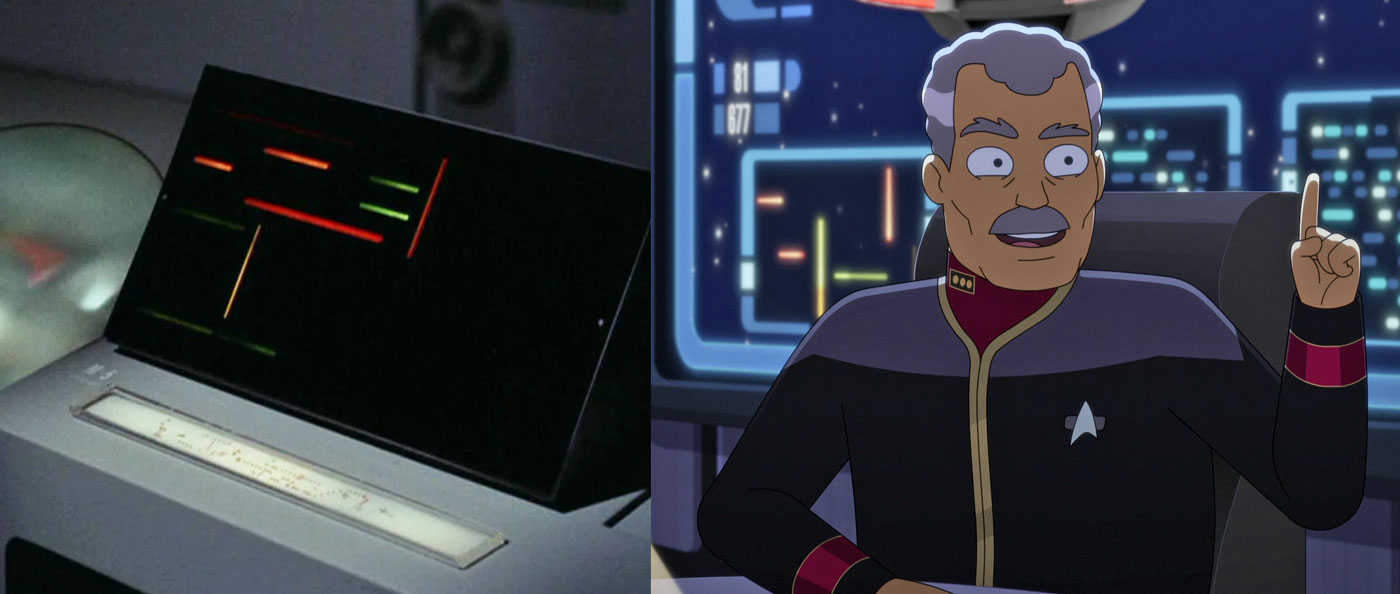
- Petra Aberdeen and the Independent Archeologists Guild are funded by Admiral Jean-Luc Picard, making this the earliest reference in the timeline to Picard being an Admiral. Mariner was hoping it would be a Xindi cabal so she’d have more of a reason to go back to Starfleet.
- When the Cerritos increases speed to try and outrun the Texas-class ships, the warm core thrum increases, just like in “Where No One Has Gone Before.” The ejection sequence also mirrors that of Voyager ejecting its warp core in “Day of Honor.”
- T’Lyn is wearing a provisional rank insignia — seen most prominently on the Maquis crew members on Voyager — signifying that serves aboard a Starfleet ship, but is not originally of Starfleet training.
OTHER OBSERVATIONS
- The episode’s title “The Stars at Night,” is the opening line from the song “Deep In the Heart of Texas.”
- Hans Federov is the full name of the ‘Towel Guy’ often seen roaming the corridors; he’s the Cerritos’ gossip king.
- Mariner’s escape from Ferengi grave robbers is clearly inspired by Indiana Jones, all the way down to a very John Williams-esque score.
- Commander Ransom teaches the famous Riker sit. “You need to sit, cross your leg over the back of it, and slam down. Command that chair!”
- The Cerritos conducts a full self-awareness assessment on the sand where they build the outpost, likely inspired by the events of “Home Soil.”
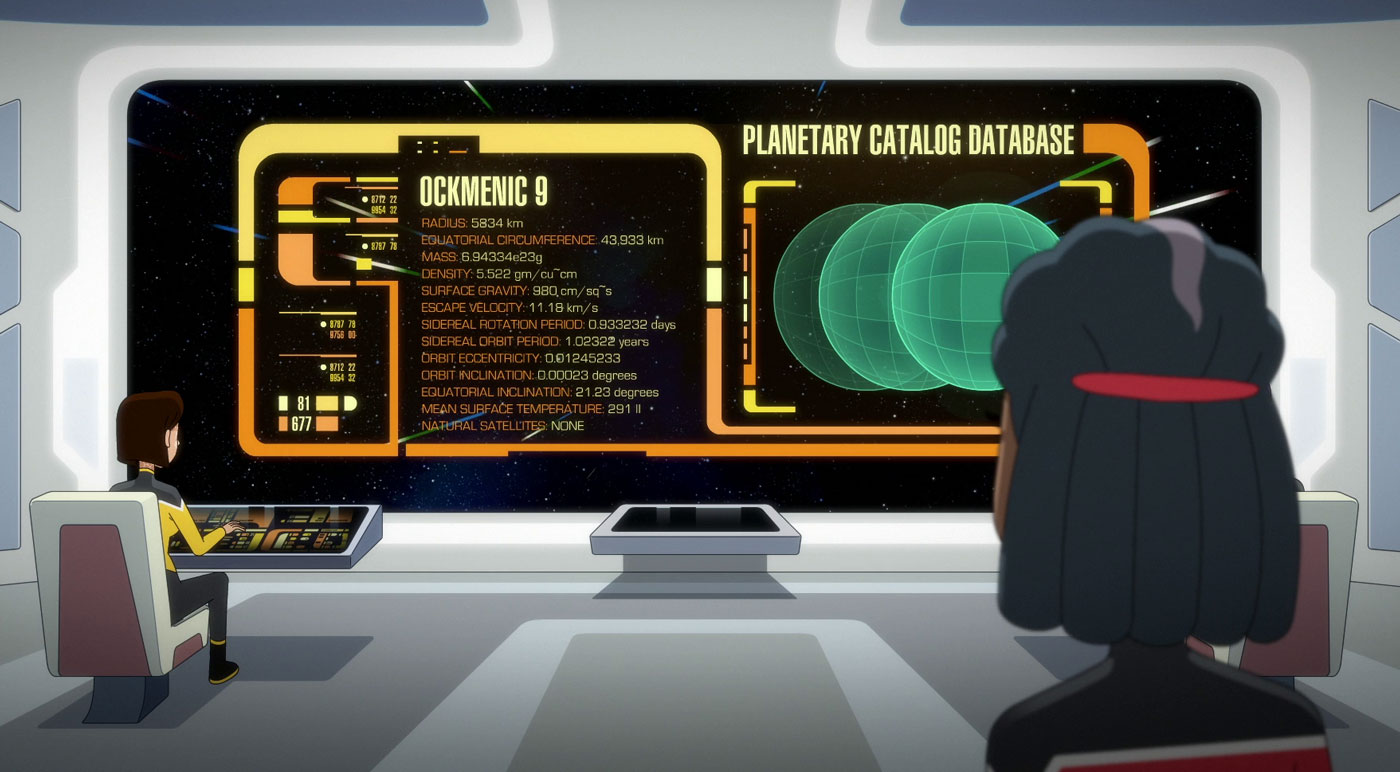
- Ockmenic 9, the planet that phases into our universe for only a couple of hours a year, is also clearly inspired by planet Meridian.
- The phaser turrets on Douglas Station look similar to the ones that were installed on Deep Space Nine prior to the events of “The Way of the Warrior.”
- The three Texas-class ships were the Aledo, the Dallas, and the Corpus Christie.
- The Sovereign-class USS Van Citters (NCC-72584) is named after John Van Citters, the longtime head of licensing for the Star Trek brand, who is now the Vice President of Star Trek Brand Development.
- The Carlsbad appeared earlier this season in “Mining the Mind’s Mines,” the USS Oakland in “Much Ado About Boimler,” the USS Merced in “Moist Vessel,” the USS Inglewood in “The Least Dangerous Game.”
- The bizarro Cerritos crew of the USS Alhambra, first encountered in “Veritas,” can be seen on the viewscreen when the California-class fleet arrives.
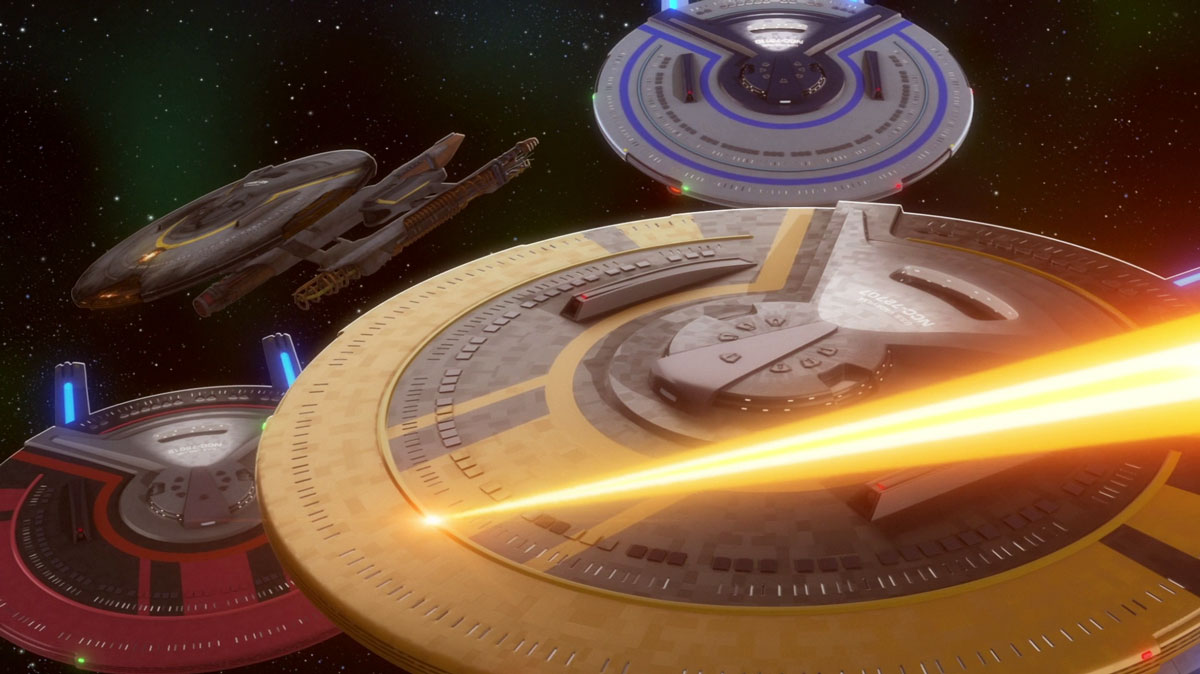
- Including the Cerritos, the California-class fleet includes 24 ships — each with subtly different hull paint designs: the Oakland, Alhambra, San Diego, San Clemente, Sherman Oaks, Vacaville, Burbank, Fresno, Santa Monica, San Jose, Sacramento, Culver City, Anaheim, Riverside, Vallejo, West Covina, Pacific Palisades, Redding, Eureka, Mount Shasta, Merced, Carlsbad, and the Inglewood.
- A battle between California against Texas seems like a bit of a commentary on today’s American political landscape, doesn’t it?
- The fleet of only California-class ships may be a subtle wry nod at the derided “copy and paste” Inquiry-class fleet led by Will Riker in Star Trek: Picard’s first-season finale.
- After a year of waiting, Vulcan outcast T’Lyn makes her first appearance after being sent to Starfleet in “wej duj” — and it looks like we’ll be seeing a lot more of her in Season 4.
Overall, I really enjoyed “The Stars at Night,” and Season 3 as a whole. While I think Season 2 was slightly better overall, the show has done something important this year: it has started to stand on its own two feet, and not simply rest on the shoulders of Star Trek’s previous adventures.
If Lower Decks was just a parade of easter eggs loosely connected by jokes, I think even the biggest Star Trek fan in the world would eventually get tired of it — but a Lower Decks that has its own stories, characters, and arcs that come to the fore more prominently than the easter eggs? That’s a Lower Decks that can last forever.
![]()
Star Trek: Lower Decks will return with new episodes in 2023.

